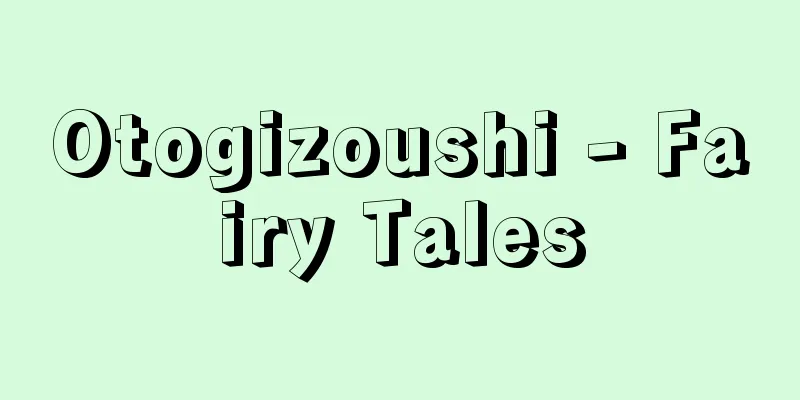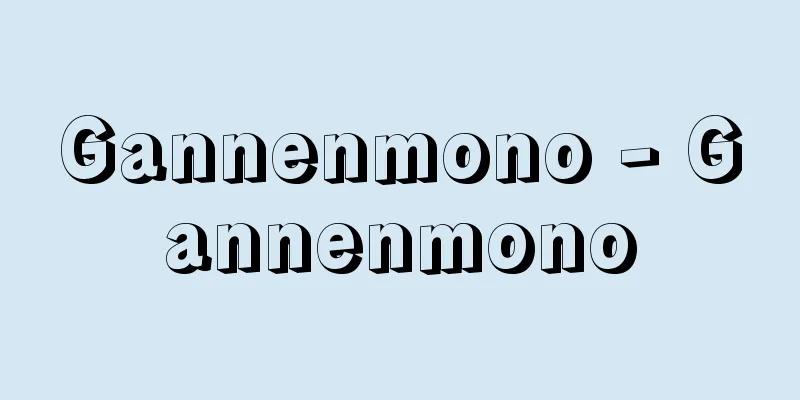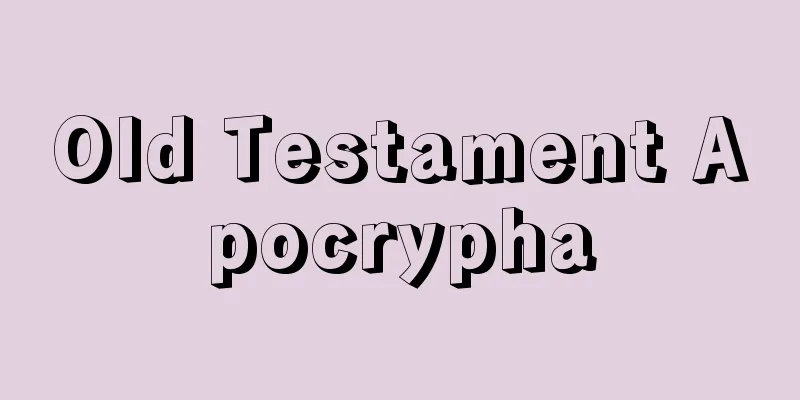Otogizoushi - Fairy Tales

|
A type of short narrative novel that appeared between the 14th and 16th centuries (the Northern and Southern Courts and Muromachi periods). Initially, the name referred to 23 works, including Bunsho Zoushi, published as a series in the Edo period, but now it is used to broadly encompass similar works and as a term to refer to a genre in literary history. There are over 300 extant works, but the authors and exact dates of creation of most of them are unknown. After the Kamakura period, as the local feudal lords, the samurai, rose to power, culture also began to spread socially and regionally, but the nationwide upheaval of the Northern and Southern Courts accelerated this. Even in the world of literature, the expansion of the base of authors and readers brought about changes and diversification in quality. Otogi Zoushi was produced as one phenomenon of this popularization of literature. Many of the Otogi-zoshi were made into picture scrolls or simplified Nara ehon, where pictures and text complement each other to entertain readers, which may also indicate that the target audience was mainly women and young people. Therefore, compared to stories about aristocratic society from the Heian period onwards, the characters and the worlds they deal with are more varied, but the creative techniques are more stereotypical and many of the stories have similar themes. The most common classification method, as proposed by Japanese literature scholar Ichiko Teiji, is into six types: stories about nobles, stories about samurai, stories about religion, stories about common people, stories about strange creatures, and stories about foreign countries. Many of the stories about nobles are adaptations of stories from aristocratic society in the Kamakura period, such as "Shigure," "The Tale of Fuseya," and "Iwaya no Soshi." These stories are about the love between a brilliant but unfortunate princess and the nobleman of the time. The samurai stories include those based on sad tales from the Genpei period, such as "Koatsumori" and "Yokobue Zoushi," tales of famous warriors slaying monsters, such as "Tawara Tōda Monogatari" and "Shuten Doji," as well as imaginative stories such as "Akashi Monogatari" that tell of incidents that occurred in the homes of local nobles, and show the new world of literature that was opened up by Otogi Zoshi. The religious stories include a wide variety of works, such as those with monks as the main characters, biographies of high priests, childhood stories such as "Aki no Yo no Naga Monogatari," stories of repentance such as "Sanninboshi," and "Sasayaki Bamboo" and "Oyo no Ama," which mock treacherous monks. Among the folk tales that spread to farming and mountain villages in the Middle Ages are honjimono, which tell of the past lives of gods and Buddhas and the origins of temples and shrines, such as "Kumano no Honji," "Suwa no Honji," and "Amida no Honji." These tales explain how men and women who suffered various hardships in the human world eventually emerged as gods and Buddhas, and are works with a particularly strong medieval flavor. Many of the common people's tales are tales of people's rise to success, as seen in "Bunsho Zoushi" and "Monokusa Taro." The stories, in which nameless commoners gain wealth through their wits or find love for noble women, reflect the social climate of the Warring States period, when the ruling classes rise to power, and exude a sense of openness and brightness. Other distinctive Otogi Zoushi works are iruimono, which are anthropomorphic versions of non-human animals and plants. These include humorous works by intellectuals and works closely related to the stories of interspecies marriage, which are common in folk tales. Foreign stories are based on Buddhist or Chinese tales and are set in India or China, and many of them are surreal stories. In addition, Otogi Zoushi often depict other worlds, such as the Dragon Palace, Horai, and Heaven. As mentioned above, the content of Otogi-zoshi is diverse, but common characteristics include the use of simple and easy-to-understand writing, short stories with little depiction of the inner lives of people, stereotypical plots, the appearance of the characters, and the depiction of the scenery, a pronounced didactic and enlightening attitude, and a strong Buddhist influence, with many works emphasizing the miraculous powers of gods and Buddhas to bring about good. As a result, there are few works that show the individuality of the author, and as literature, they cannot escape criticism of being childish and simple, but this is probably an inevitable phenomenon during a transitional period when literature, which had been the monopoly of the upper classes, was becoming popular. Among Otogi-zoshi, works with a relatively high level of creativity influenced Kanazoshi, and stories that were popular among the general public, such as samurai stories and religious stories, flowed into Joruri, a form of narrative entertainment that involves puppetry, during the Edo period, and survived for a long time. [Takanobu Matsumoto] "The Series of Japanese Classical Literature, 38: Otogi-zoshi, edited by Ichiko Sadatsugu (1958, Iwanami Shoten)" ▽ "The Complete Works of Japanese Classical Literature, 36: Otogi-zoshi, edited and translated by Oshima Takehiko (1974, Shogakukan) " ▽ "Illustrated Japanese Classics, 13: Otogi-zoshi, by Ichiko Sadatsugu et al. (1980, Shueisha) " ▽ "Research on Medieval Novels, by Ichiko Sadatsugu (1955, University of Tokyo Press)" [Reference] | | |The story of the origin of Kumano Sansho Gongen. It had a great influence on the propagation of Kumano faith. Tanryokuhon "Kumano Honchi" Published in the first half of the 17th century (late Kan'ei to around Shoho) Owned by the National Diet Library "The Home of Kumano" A fairy tale about the common people. It is a happy story of attaining wealth, success in life, and long life. Included in the "Sansoshi Emaki" (Picture Scroll of the Three Herbs). Copy held at the National Diet Library . "Bunsho Zoushi" A lazy man living in Shinano Province marries a beautiful woman, becomes wealthy and prosperous, and is later worshipped as a god. This story reflects the meritocracy of the times. Nara Ehon (Manuscript) held at the National Diet Library "> "Monokusa Taro" Source: Shogakukan Encyclopedia Nipponica About Encyclopedia Nipponica Information | Legend |
|
およそ14世紀から16世紀の間(南北朝・室町時代)に現れた短編の物語小説。最初は、江戸時代に入って叢書(そうしょ)として出版された『文正草子(ぶんしょうぞうし)』以下23編の作品をさす名称であったが、現在では同類の作品を広く包括して、文学史上の一ジャンルを意味する術語として用いられる。現存する作品は300編を超えるが、大部分は作者も正確な成立年代も不明である。鎌倉時代以後、地方豪族である武家が台頭するに及んで、文化もまた社会的、地域的に拡散することになったが、全国的規模の南北朝の動乱はそれに拍車をかけた。文芸の世界にあっても作者と享受者層の裾野(すその)が広がったことによって、質の変化と多様化を招来した。そのような文学の大衆化の一現象として輩出したのが御伽草子である。 御伽草子の多くは絵巻や、それを簡便化した奈良絵本に仕立てられ、絵と文とが相補って読者を楽しませる方式をとっているが、これも、対象とする享受者が女性や若年層を主にしていたことを示しているのであろう。したがって、平安時代以来の貴族社会の物語に比べると、登場人物や扱われた世界は変化に富んでいるが、創作手法は類型化し、主題の似通った作品も多い。分類としては、国文学者である市古貞次(いちこていじ)による、公家(くげ)物、武家物、宗教物、庶民物、異類(いるい)物、異国物の6種に分ける方法が一般的である。公家物には『しぐれ』『伏屋(ふせや)の物語』『岩屋(いわや)の草子』など、鎌倉時代の貴族社会の物語を改作した作品が多い。それらは、才色に優れながら不遇な境遇にある姫君と、時の貴公子との恋を主題にした物語である。武家物には『小敦盛(こあつもり)』『横笛草紙(よこぶえぞうし)』など源平時代の哀話に取材したものや、『俵藤太(たわらとうだ)物語』『酒呑童子(しゅてんどうじ)』など高名な武人の怪物退治談のほか、『明石(あかし)物語』のように地方豪族の家に起こった事件を語る創作的な物語もあり、御伽草子によって開けた新しい文学の世界をみることができる。宗教物は僧侶(そうりょ)を主人公にした作品に、高僧の伝記物、『秋の夜(よ)の長(なが)物語』のような児(ちご)物語、『三人法師』を代表作とする懺悔(さんげ)談、破戒僧を揶揄(やゆ)した『ささやき竹』『おようの尼』など、多様な作品を含む。また、中世の農山村にまで広まっていた民衆的な物語に、『熊野(くまの)の本地(ほんじ)』『諏訪(すわ)の本地』『阿弥陀(あみだ)の本地』など、神仏の前生、寺社の縁起(えんぎ)を語る本地物がある。それらは、人間界でさまざまな苦難を味わった男女が末に神仏と顕(あらわ)れたことを説く物語で、とくに中世的な色彩の濃い作品である。庶民物には『文正草子』や『物くさ太郎』で知られる立身出世談が多い。名もない民が才知によって富を得たり、高貴の女性への恋を成就するといった内容は、戦国時代の下剋上(げこくじょう)の世相を映し、開放的な明るさを漂わせている。人間以外の動物や植物を擬人化した異類物も御伽草子の特徴的な作品である。これには、知識人の戯作と、民間説話に多い異類婚姻談と関係の深い作品とがある。異国物は仏教説話や中国の説話を種に、天竺(てんじく)や唐土(とうど)を舞台に構えた作で、多くは超現実的な話である。そのほか、御伽草子には竜宮や蓬莱(ほうらい)、天界といった、この世に対する他界もしばしば描かれている。 以上のように御伽草子の内容は種々雑多であるが、共通した特徴としては、文章が平易単純であること、人間の内面描写が乏しく、筋書き的な短編であること、筋立てや、また人物の容姿や情景の表現が類型的であること、教訓的、啓蒙(けいもう)的な姿勢が顕著なこと、仏教思想が濃厚で、とくに神仏の霊験利生(れいげんりしょう)を強調する作品の多いことなどがあげられる。したがって作者の個性のみられる作品が少なく、文学としては幼稚素朴の評を免れないが、これも、上層階級の独占であった文芸が大衆化する過渡期にあっては、やむをえない現象であろう。御伽草子のうち、比較的創作性の濃い作品は仮名草子(かなぞうし)に影響を与え、武家物や、宗教物のなかの本地物のように、民衆に迎えられた物語は、江戸時代に入ると、操(あやつ)りを伴う語物芸能の浄瑠璃(じょうるり)に流入して、長く生命を保っていた。 [松本隆信] 『市古貞次校注『日本古典文学大系38 御伽草子』(1958・岩波書店)』▽『大島建彦校注・訳『日本古典文学全集36 御伽草子集』(1974・小学館)』▽『市古貞次他著『図説日本の古典13 御伽草子』(1980・集英社)』▽『市古貞次著『中世小説の研究』(1955・東京大学出版会)』 [参照項目] | | |熊野三所権現の由来物語。熊野信仰の教宣に大きな影響を与えた。丹緑本『くまのゝほんち』 17世紀前半(寛永末~正保ごろ)刊国立国会図書館所蔵"> 『熊野の本地』 庶民物の御伽草子。致富、出世、長寿という、めでたずくめの物語である。『三草紙絵巻』所収 写国立国会図書館所蔵"> 『文正草子』 信濃国に住む無精者が、美女をめとり、富貴に栄え、のちには神として祀られる。実力主義の世相を反映した物語である。奈良絵本 写本国立国会図書館所蔵"> 『物くさ太郎』 出典 小学館 日本大百科全書(ニッポニカ)日本大百科全書(ニッポニカ)について 情報 | 凡例 |
Recommend
Telegram - denpo (English spelling) telegram
A service in which communication content is trans...
History Country - Fumikuni
A haiku poet of the early Edo period. Dates of bir...
Filmer - Sir Robert Filmer
A leading proponent of the divine right of kings ...
Bergius (English spelling) Friedrich Karl Rudolf Bergius
German chemical engineer. Born the son of a chemi...
Gasoline railcar - Gasorindosha
...A general term for railroad cars that can carr...
Hiromi [town] - Hiromi
This is an old town in Kitauwa District, occupying...
Ostranenie theory - Ostranenie theory
…Russian and Soviet writer and critic. Born to a ...
Promiscuity
...There is a hierarchy among males, with dominan...
Obata Seto - Obata Seto
A narrow strait in the southeastern part of Yamagu...
Montserrat (mountain) (English spelling)
A mountain in the province of Barcelona in the Cat...
Nago [city] - Nago
A city in the northern part of Okinawa Island, Oki...
Arnulf of Carinthia (English spelling)
Around 850-899 King of East Franks. Reigned 887-89...
Wei Suzhou
…In his youth, he served Emperor Xuanzong as a gu...
Tsuyama [town]
A former town in Motoyoshi County in the northeast...
Hahah
… The pioneers of the landscape garden style were...









